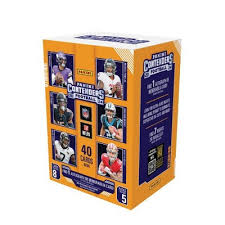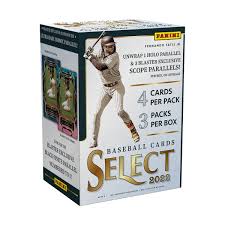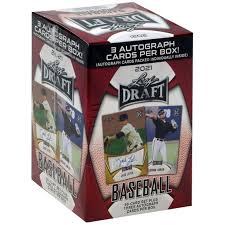

Panini adopted the Dutch auction bidding system when the sports card market took off in late 2019 and early 2020. It remains key to obtaining Panini boxes today. We’ll look at the Dutch auction in today’s story. Stick with Cardlines for our comprehensive Panini Dutch auction guide.
“How much do you think this card is worth?” “As much as somebody will pay for it.”
If you’ve spent much time on a sports card Facebook page or online forum, you’ve probably seen an exchange like the one above. The answer is undoubtedly annoying to the person. However, it happens to be true. And this fact informed Panini’s decision to adopt Dutch auctions.
Please note, Dutch auctions have been around for a long time. They did, however, introduce it to sports cards.
Here’s how it works: the price starts at a very high number. It then decreases at consistent intervals. Eventually, when the price hits a “fair market value,” the product will sell out.

This is what a Panini Dutch auction looks like (picture taken from Reddit)
Let’s use an example here:
Imagine you sell wristwatches and wall clocks. You’ve always sold the wristwatches for $20 and clocks for $100. But suddenly, somebody buys all of your wristwatches at $20 and begins to sell them at high volume for $100. Now, you’re worried about selling your wall clocks for too cheap. What if you’re selling them for $100, but they could be sold for $500? How should you price them?
Panini faced a similar situation during the big card market explosion. Blaster boxes began to resell for 5x the price tag, and hobby boxes were snatched upon release.
To make the most of the situation, Panini implemented the Dutch auction system on their website. Investopedia defines a Dutch auction as “a market structure in which the price of something offered is determined after taking in all bids to arrive at the highest price at which the total offering can be sold. In this type of auction, investors place a bid for the amount they are willing to buy in terms of quantity and price.” Historically, it’s a relatively reliable method for determining market value.
Panini utilizes a modified formula. Nonetheless, it safeguards against underselling. They initially asked for a price estimated as well above market value. Then lowered it until people started buying.
Collectors were dismayed by the move away from standard pricing. Nonetheless, from Panini’s perspective, it was a savvy business move.
The first Panini Dutch auction was the 2019-20 FOTL Prizm Premium Edition Hobby Box.
The auction took place on Dec. 2, 2019 – aka, Cyber Monday – and the boxes began with an opening price of $1,000 before dropping every 2 minutes until the product sold out.
Panini shared a blog post explaining everything collectors needed to know before the Dutch auction. For example, collectors learned there would be no guest checkouts and a cap of 12 boxes per transaction.
The Dutch auction was successful, selling out quickly before prices fell to $900. It helped Panini establish a better idea of how to price their cards. Collectors also did well. Even individuals who pulled the trigger at the $1,000 release price – could sell them for $2,500 today.

The people who bought this box in the first Panini Dutch auction got a good deal (look for FOTL Prizm Premium Edition Hobby Boxes on eBay)
Are you thinking of trying your hand in a Panini Dutch auction? Of course, a successful Dutch auction starts with a winning playbook. So here is a game plan to nail that box with no regrets.
Timing is crucial for a Dutch auction. You don’t want your product to sell out when it finally gets to the price you want because you have to register.
To prevent this, make sure you not only have a Panini account – be logged into it, too. That way, when boxes hit the magic number you’re waiting for, you can seamlessly go to your cart and check out.
Additionally, add the boxes to your cart before you’re ready to pounce on the price. The box price will update in your cart as the auction continues. So just because they cost $1,000 when you added them to your cart doesn’t mean you won’t be able to buy them for $650 if the price falls to that level. It’s another time-saving trick.

Log into the account and add the boxes before you bid.
The more people make orders on the site, the slower the Panini website will run. Therefore, if the website is running smoothly, you probably have time. But when you have trouble refreshing and loading, that means many people are getting in on the action. So it is perhaps time to pull the trigger.
Here’s the number one way to leave a Dutch action without regret: know the max price you’re willing to pay. Then, whatever happens, don’t reach beyond that number.
Much like an eBay auction, it’s easy to get caught up in the excitement of the auction and overspend. But how do you know what price you should pay?
The easiest way to estimate value is to look at previous boxes of the same brand on eBay. In other words, if you’re buying a Dutch auction of Product X 2021-22 basketball, look at the resell prices of Product X for 2020-21 and 2019-20 on eBay. To render the comps more accurate, be sure to look at “sold” products, not asking prices. Seeing what these cards are going for will help you value the new release.
Now that you’re a savvy Dutch auction expert, it’s time to try your hand at Panini Dutch auctions.
But remember! With every Dutch auction Panini runs, they learn more about pricing, and it becomes harder for them to “lose.” While the first Dutch auction began at $1,000 for boxes that sell for $2,500 today, the odds of you making that return in such a short time on a Dutch auction two years later is slim-to-none. Remember, Panini wants you to overpay and start the Dutch auction with too high of a price – as they should, that’s the point.
I hit a SWEET auto from the #1 overall pick at PCB hobby
The Ultimate 2024 Football Card Brand Tier List (Panini vs. Topps and more!)
2025 Topps All Star Game Mega Box Product Review
Ripping the new Topps All Star Game mega box.
Is this new sports card store the BEST VALUE around?
I Tested eBay Auction Promotions So You Don’t Have To!
I deep-dove on Fanatics Collect so you don't have to (but should you?)
Panini is launching a WNBA Product at $30,000!?







2022 Topps Heritage Baseball Blaster Box Configuration: 7 Packs per Box – 9 Cards per Box. Plus 1 extra pack.









Keep up on breaking Sports Card News, our latest articles, product specials and exclusive content with expert analysis of hobby trends.

© Copyright 2025 - All rights reserved Cardlines.com / Media Techs LLC - Sports Card News, Reviews, Releases and BREAKS - #thehobby.
Important: When you click on links to various merchants on this site and make a purchase, this can result in this site earning a commission. Affiliate programs and affiliations include, but are not limited to, the eBay Partner Network.
Sports Card Scavenger Hunt! (5,000 Subscriber Special!)
Cardlines July 11, 2025 9:01 am